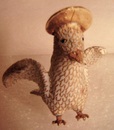
Cosmopolitan and crowded (for Dutch standards), Amsterdam uniquely blends the advantages of a little village and a modern city. Nevertheless, it's intrinsic housing problems raise a lot of issues - namely if you have children. Most Dutch cultivate their families' independence from family, which, added the fact that relatives usually live far away - more than 20 minutes biking -, leaving your kids with granny is out of the question. So, a kinderdagverblijf is mandatory: literally a child-day-stay.

Among the many good examples of openness of mind and practical thinking Amsterdam has to offer, my favourite is located in the city's perfect place to seek for a connection with the Divine, pleasure and comforting redemption: the Red Light District. Or, more precisely, the Oudekerk (Old church). This church, Amsterdam's oldest building, is one of the very few survivors of the big fires of 1421 and 1452 responsible for the destruction of most of the city and the light bricked wall innovation that gives Dutch houses their typical appearance, as building wood-based walls was forbidden since then. Located in the heart of the Red Light District, the Oudekerk is surrounded by one of the many sexual gourmet options the area has to offer: the D.S.O.W.F.W. - dark-skinned, over-weighted female workers, commonly referred to as BBL - big black ladies.
So, walking around the Oudekerk square we can admire the imponent Gothic building (my automatic language corrector insists on replacing imponent with impotent, how gracious!) along with a myriad of sex professionals. Being a part-time tour guide in Amsterdam allowed me to explore these streets with many tourists, namely Americans, who get particularly impressed with the contrasting cultural realities. But the big shock is yet to come, and amazement reigns as we go along the alleys: on the Northern side of the square, opposite the church and between the windows with half naked fat women, we discover the Prinses Juliana Kinderdagverblijf, where many Dutch parents leave their kids for day-care. So, church on the left, prostitutes on the right - and they work 24/7, kindergarten in the middle. Not bad as an early age mind-openness exercise, toch?

Children, big ladies and Red light, check! But where's the Virgin? Still missing - and that was the most promising and mysterious part of this post's title! The virgin I refer to is a singular carving on the church's wall, where the Annunciation scene is depicted in the most challenging way: an angel sends the Holy Spirit/Ghost dove to Mary, who, opening a book, gently turns her head back. Between them, a vase with three white lilies. All these elements (angel, Mary, dove, lilies) are typical Annunciation attributes - the challenge comes from the presence of the caduceus (the stick with the snake) in the angel's right hand, the vase and the book being opened, all key elements of mythology and alchemy.

- symbolically, the Annunciation is a central Christian dogma and a true crossroad for religious, esoteric, alchemical and mythological interpretations - a women will conceive God's child, fertilised by the Holy Ghost; scary!
- culturally, because of this dogma's implications of purity and virginity, this scene is a key-piece and fundament female sexual repression and the overall concept of sex as sin;
- historically, it's dated 1571, referring to the construction of the new Chamber, next to Mary's Chapel.
So, it's made after the 1566 Protestant riots that destroyed most of the church's icons and images, and also spared by the to the Protestant Reformation of 1578, in which the formerly Catholic building became Calvinist. Therefore, along with the ceiling paintings and the Choir stalls of the choir (with many interesting depictions, among them the Misericord), the Annunciation scene is one of the few survivors of the violent iconoclast attacks the building suffered throughout the centuries.

If there's something I love about Amsterdam is the opportunity everyone has to pursuit the life-style they want. Non-judgemental, independent and laid-back, Amsterdam's inhabitants grow up respecting and accepting cultural differences, what has proven to be one of the city's main historical assets: it was referred as "the New Jerusalem", given its receptivity to the free-thinking, educated and wealthy, namely Jewish, people that fled from Southern Europe in the middle-sixteenth century. Bringing know-how, money and an adventurous spirit, they settled the very beginning of what would turnout to be the Dutch Golden-Age...
The little, almost un-noticed, carving in the Northern side of the Oudekerk, amazingly documents the fascinating Human activity: ideas of purity, religious revolutions, repression and liberating touristic visits to the core of sexual fantasy. What an extraordinary paradox, it's presence in the Red Light District, so lively, full of colour and preserved for more than four centuries, doomed to face the everyday innocence of the Dutch kids, by the hand with their parents, on their daily walk next to the sinful activity of the Big black ladies! Toch?
Text and photos: Rafael Fraga © 2013, except Red light photo by Mario
rafaelfragamusic |at| gmail.com
> The symbolical, alchemical and mythological content of Oudekerk's Annunciation high-relief.
> The Belém Custody jewell.
More about the Oude Kerk and its choir stalls.






 RSS Feed
RSS Feed
